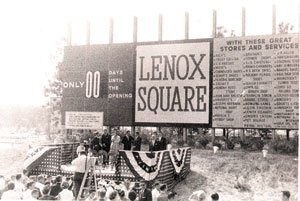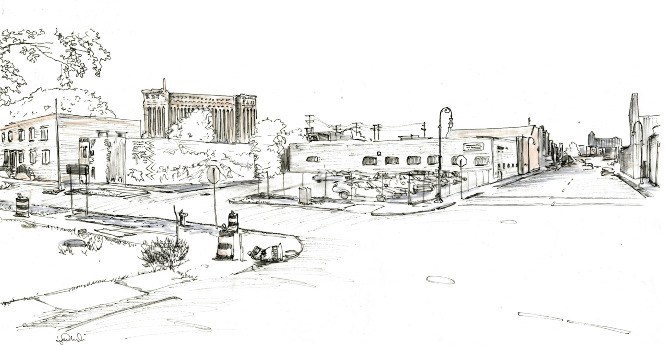I was walking by Little 5 Points to get to Aurora Coffee Shop one afternoon. I was wearing some ripped jeans, a flannel, and my favorite Vans. I walked into Aurora and not one head turned. I got my tea from there and I left. I went to Buckhead right after to go to Lenox Mall. Once I started walking toward the mall through the parking lot, I noticed a lot of people staring at me; a lot of men and women in suits and business attire. It hit me instantly. Buckhead and Little 5 Points have different expectations. Buckhead and Little 5 Points are very different in regards to the urban design theory, how they are designed and built, who they attract, and what their purpose is.
Buckhead has a very interesting background to how it became “Buckhead”. This is important because it gives a sense of why it is the way it is. In 1838 a man named Henry Irby purchased some land near the intersection of what is now Peachtree, Roswell, and Wes Paces Ferry Road. On this land, he built a tavern and grocery store. Once these were built, a community as born. The city got its name from a story that says Irby killed a buck and hung the head in his tavern. The area started out as a prime place for summer and country homes for Atlanta’s wealthiest people. Many of the large estates were sold off, allowing for some of the most famous and prestigious commercial development in the southeastern portion of the United States. The modern design of Buckhead came about from its history because it had started as a chunk of land only for the wealthiest people. Today, Buckhead real estate development milestones include Lenox Square built in 1959, which is the largest shopping center in the southeast and Phipps Plaza, another luxurious shopping center built soon after Lenox. In 1974, Tower Place was built and paved the way for future high-rises in Buckhead. Then in 1984, the flagship Ritz Carlton was built, which helped lead the Buckhead community further in deluxe accommodations and luxury.
This is a photo of Buckhead when it was first starting to develop. I’m not sure what year this was, but it was between 1830-1900.
Because of the sheik, modern design of Buckhead, it attracts a more upscale population. It is definitely a place of business and is also a big tourist attraction because of Lenox Mall. This area also attracts a lot of celebrities for a few reasons: the hotels in this area are four star or 5 star hotels, as well as the restaurants in this area. Buckhead serves as a tourist attraction because of Lenox Mall and Phipps Plaza, it serves as a luxurious real estate attraction, a luxurious shopping area, as well as a business attraction.

This photo was from when Lenox Mall had just been developed. It was built around August in 1959, and was the first mall, not just in Atlanta, but in the region.
Little 5 Points is also the way it is because of its history. This area is the total opposite of Buckhead. The first streetcars were built a little south of 5 Points in the 1890s. As the population grew, it became one of the earliest, major regional shopping centers. By the 1970s, it had started to decay, until urban pioneers and designers started restoring the homes in the area. Soon after, local merchants formed the Little 5 Points Partnership to restore and revitalize the area.

Little 5 Points being developed and restored.
Little 5 Points has a very alternative vibe as well as alternative population. Little 5 Points is home to Indie Radio stations, coffee shops, skate shops, and any more things. It has very edgy spirit, not just within the people, but from the design of the buildings, to the paintings and graffiti on these buildings. I also noticed it as a lot of vintage stores and style. This area attracts tourists, like Buckhead, it attracts artists, skaters, and in vague terms “hippies”. Little 5 Points serves as a shopping attraction, a tourist attraction, and offers more retail than real estate.

This picture shows how alternative the design of these shops are. They are very flashy and unique.
When it comes to Urban Design and how things are built, we turn the theory of Urban Design. My point that I make, when I say that history shaped the way that Buckhead and Little 5 Points are, is supported by the Urban Design Theory. “…urban design process begins long before contemporary development proposals are dreamt up, and these in turn build upon a very long history that continues to inform processes of change through to today” (Carmona, 12). With that statement, it says that urban design, whether we know it or not, roots from the history of the place. This statement is true for both Buckhead and Little 5 Points. These areas were later designed based on their history and how they came about.
When it comes to addressing the way these areas are designed, who they are designed for, and why they are built, an article exposes these concepts with questions. The author of this article brings up two types of questions based on the idea of urban design. The first question “is related to diagnostic and analytical methods – what type of qualities? And for whom? And how to read/identify them?” (Khan, 396). The second question is “how to address, implement, develop and manage those qualities and who is/should be involved?” (Khan, 396). He claims that the answer to these questions is “spatial qualities”. Buckhead was built on a foundation that supported wealthier living but Little 5 Points was brought up from a run-down area. The qualities of the spaces were important to the growth of these areas and development. It’s not just design that shapes space and how it is developed:
Thus it is not just design, nor even development processes, that shape the experience of space, but instead the combined outcomes and interactions between: Design—the key aspirations and vision, and contextual and stakeholder influences for a particular project or set of proposals. Development—the power relationships, and processes of negotiation, regulation and delivery for a particular project or set of proposals. Space (or place) in use—who uses a particular place, how, why, when and with what consequences and conflicts. Management—the place-based responsibilities for stewardship, security, maintenance and ongoing funding. (Carmona, 33)
Another important factor in designing these areas were conceptual and instrumental influences in urban planning and the graphic representations of these areas. During the times these areas were being developed, “the graphic representation of urban planning during the twentieth century were scarce” (Gomis, 47). This plays a role in how detailed the development of these areas were, and could have been.

This an example of a sketch of urban design. I could not specifically find anything for Buckhead or Little 5 Points, so this is just an example.
When comparing Buckhead to Little 5 points, it goes deeper than just their appearance. It all comes down to their history, who they were built for, why they were built, and how they were designed. Urban design and urban planning plays a big role in these factors. Urban design is based on not just history, but history is a big detail in planning. It has been concluded, not officially, that design is not the only factor that is part of designing spaces. We must consider design, development, the space itself, and the management of that space. It’s also important to consider influences such as conceptual and instrumental when looking at graphic representation of these areas. Appearance, who these areas attract, what their purpose is, how they are designed and built, and the graphic representations of spaces are all important factors explained by the urban design theory. These are all factors to consider when thinking about the built environment, as well as urban design.
Works Cited
Carmona, Matthew. “The Place-Shaping Continuum: A Theory Of Urban Design Process.” Journal Of Urban Design 19.1 (2014): 2-36. Academic Search Complete. Web. 28 Apr. 2016.
GOMIS, Jordi, Carlos TURÓN, and Ramon RIPOLL. “Conceptual And Instrumental Influences In The Graphic Representation Of Urban Planning During The 20Th Century.” Geographia Technica 10.2 (2015): 41-49. Academic Search Complete. Web. 28 Apr. 2016.
Khan, Ahmed Z., et al. “Integrative Spatial Quality: A Relational Epistemology Of Space And Transdisciplinarity In Urban Design And Planning.” Journal Of Urban Design 19.4 (2014): 393-411. Academic Search Complete. Web. 28 Apr. 2016.
Leave a Reply